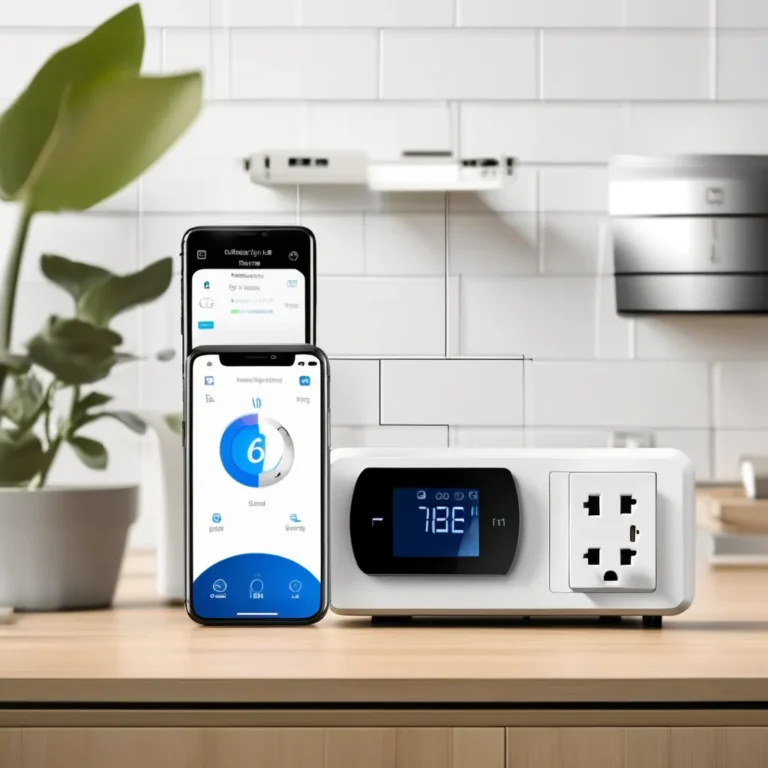In today’s world, smart home appliances have become the cornerstone of modern living, bringing convenience and efficiency to our homes. Among these innovations, smart plugs are one of the easiest and most affordable ways to dive into home automation. If you’re curious about how to start automating your home, this beginner’s guide will take you through everything you need to know about smart plugs, helping you confidently bring the magic of technology into your daily routine.
What Are Smart Plugs and Why Are They Essential for Smart Appliances?

Imagine controlling your everyday devices, like lamps or coffee makers, through your smartphone or a simple voice command. Smart plugs are small, often compact devices that you can plug into your standard wall outlet. Once connected, they allow you to control the power of any appliance plugged into them, transforming ordinary gadgets into smart appliances for the home.
Think of it this way: your old table lamp can become part of your smart home setup without buying a new one.
How Do Smart Plugs Work to Automate Your Home Appliances?
At their core, smart plugs act as a bridge between your appliance and the power outlet. Here’s a simple breakdown:
Plug the smart plug into your wall outlet.
Connect your appliance (like a lamp, fan, or coffee maker) to the smart plug.
Download the corresponding mobile app for the smart plug and follow the setup instructions.
Use the app or a smart assistant (like Alexa or Google Assistant) to control the power.
By integrating with your Wi-Fi network, smart plugs allow you to control your devices remotely, schedule their operation, and even monitor their energy usage, making them the perfect solution for automating your home.
The Benefits of Using Smart Plugs for Automatic Appliance Control in Your Home
Convenience and Control with Smart Appliances for Home
One of the most significant advantages of smart plugs is their convenience. Picture this scenario: You’re cozied up in bed but forgot to turn off the living room lamp. With a smart plug, you can switch it off from your smartphone without getting up.
Energy Efficiency and Cost Savings with Automatic Appliances for Home
Smart plugs can help reduce your energy consumption. You can reduce unnecessary energy costs by scheduling your appliances to turn off when not in use or monitoring their power usage. For example, you can set your space heater to turn off automatically when you leave the house, saving energy and money.
Safety and Peace of Mind with Smart Plugs
Did you forget to turn off the iron? With a smart plug, you can check the status of your appliance and turn it off remotely, ensuring peace of mind and safety for your home.
Seamless Integration with Smart Home Ecosystems for Automatic Appliances
Smart plugs often integrate seamlessly with other smart home devices, creating a cohesive system you can control with a single app or voice assistant. You can set routines like “Good Night,” where all your connected devices turn off with one command.
Getting Started with Smart Plugs to Control Your Automatic Appliances for Home: A Step-by-Step Guide
Ready to start automating your appliances? Here’s a simple step-by-step guide to get you going:
Step 1: Choose the Right Smart Plug for Your Smart Appliances for Home
Various smart plugs are available on the market, each with its own features. Some are compatible with specific ecosystems like Apple HomeKit, while others work best with Google Assistant or Amazon Alexa. Consider these factors:
Compatibility with your existing smart home setup
Energy monitoring features
Ease of use and setup
Step 2: Set Up the Smart Plug to Automate Your Home Appliances
Plug the smart plug into an outlet.
Download the manufacturer’s app from the App Store or Google Play.
Follow the app instructions to connect the smart plug to your Wi-Fi network.
Name your plug (e.g., “Living Room Lamp”) for easy identification.
Step 3: Connect the Smart Plug to a Voice Assistant for Hands-Free Control
If you use a voice assistant like Alexa, Google Assistant, or Siri, you can link your smart plug to these services:
Real-Life Applications of Smart Plugs to Automate Appliances for Home
Morning Routines with Smart Plugs and Smart Appliances for Home
Imagine waking up to a perfectly brewed coffee and your favorite morning playlist. With a smart plug, you can automate your coffee maker and connect it to a smart speaker. Set up a routine where both devices activate at a specific time, making your mornings more enjoyable.
Vacation Mode with Smart Plugs for Automatic Appliance Control
When you’re away on vacation, smart plugs can help simulate your presence at home by turning lights on and off at random intervals. This simple trick can deter potential burglars and give you peace of mind while away.
Helping the Elderly with Automatic Appliances for Home
For elderly family members, smart plugs can make life easier and safer. Instead of bending down to unplug devices, they can use a smartphone or voice command to control appliances. This reduces the risk of accidents and makes everyday tasks more manageable.
Choosing the Best Smart Plug for Your Automatic Appliances at Home
When selecting a smart plug, consider the following:
Integration: Ensure it works with your smart home ecosystem.
Features: Do you need energy monitoring or USB ports?
Size: Some smart plugs are bulky and may block other outlets.
Research and compare different models online to find the best fit for your home.
Open your voice assistant app.
Add the smart plug by following the app’s instructions.
Start using voice commands like “Turn off the living room lamp.”
Step 4: Schedule and Automate Your Appliances for Home with Smart Plugs
Most smart plug apps allow you to set schedules. For example, you can set your coffee maker to start brewing every morning at 7 AM. This way, you’ll wake up to the smell of freshly brewed coffee without lifting a finger.
Step 5: Monitor Energy Usage with Your Smart Plugs
Some smart plugs come with energy monitoring features, giving you insights into how much power your appliances use. This can help you make smarter decisions about your energy consumption.
Conclusion
Incorporating smart plugs into your home is an easy and affordable way to start automating your appliances and enhancing your everyday life. Whether for convenience, energy savings, or added security, smart plugs offer a flexible solution for modern living. With the right plug, app, and a bit of setup, you can effortlessly transform your home into a smart home. Ready to take the plunge? Start shopping for smart plugs today and experience the future of home automation!
Frequently Asked Questions (FAQ)
What appliances can I use with smart plugs?
What appliances can I use with smart plugs?
You can use smart plugs with most household appliances like lamps, coffee makers, fans, etc. However, they are best suited for non-high-power devices.
Do smart plugs consume a lot of energy?
Smart plugs consume minimal energy. They are designed to be energy efficient, often using only about 1-2 watts when idle.
Can smart plugs work without Wi-Fi?
Most smart plugs require Wi-Fi for remote control features, but some offer Bluetooth connections for local control.
Are smart plugs safe to use?
Yes, smart plugs are generally safe. They include built-in safety features like overload protection to prevent overheating and other potential hazards.
How do smart plugs contribute to energy savings?
By allowing you to monitor and control appliance usage, smart plugs help reduce unnecessary power consumption, leading to lower energy bills.
Can I use a smart plug with multiple devices?
You can use a smart plug with a power strip to control multiple devices, but ensure the total power consumption doesn’t exceed the plug’s rating.
Are smart plugs compatible with all smart home systems?
Most smart plugs are compatible with popular smart home systems like Amazon Alexa, Google Assistant, and Apple HomeKit. Check the product specifications for compatibility.
By following this guide, you’ll be well on your way to mastering the use of smart plugs and integrating them into your daily life. Happy automating!



